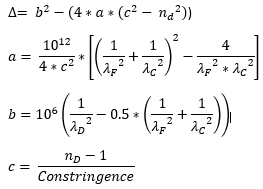Index Variation
For Isotropic or Fluorescent material, you must select the model used to describe the index variation. This can be by giving index in function of wavelength, using the SellMeier formula, using the Kettler-Helmholtz formula or index and constringence.
Refractive index from constringence formula:

with λ in nm: λF = 486.1 nm λD = 587.6 nm λC = 656.3 nm
nD the refractive index at 587.6nm
 with:
with: 
For Birefringent material, you must select the model used to describe the index variation. This can be constant index, using the SellMeier formula or using the Kettler-Helmotz formula.
Uniaxial positive material is when na=nb < nc, na and nb are ordinary index. Uniaxial negative material is when na<nb=nc, nb et nc are ordinary index. Biaxial material is when na # nb # nc. na, nb,nc are the refractive index for the referential in which the dielectric tensor is diagonal.
You must have na < nb < nc.
For Metallic material, you cannot use a model to describe the index variation in function of wavelength. You must set the index values directly in the table.
The Index variation is here composed of two parts : the real part and the imaginary part. This is because, for a metallic material, the index of refraction is a complex number composed of a real part and of an imaginary part. The index of refraction corresponds to n-i*k, n being the real part and k the imaginary part.
You can select the Real and Imaginary check boxes in Spectrum to respectively display real and imaginary parts' spectra.


